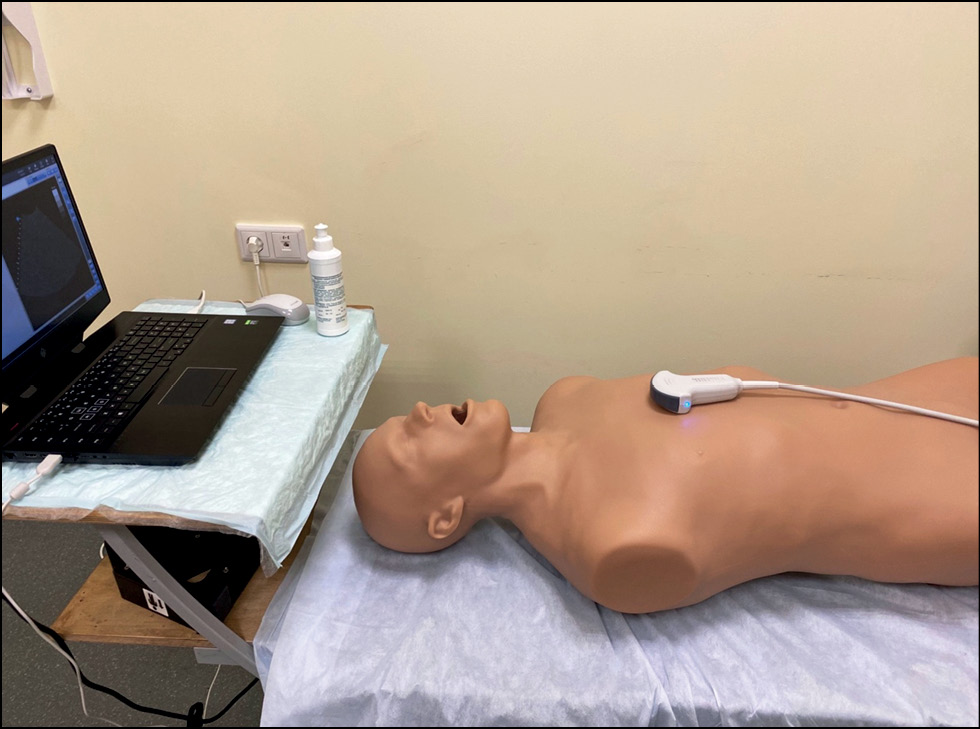Possibilities for using the Vimedix 3.2 virtual simulator to train ultrasound specialists
- Authors: Vasilev V.А.1, Kondrichina S.N.1
-
Affiliations:
- Petrozavodsk State University
- Issue: Vol 5, No 1 (2024)
- Pages: 41-52
- Section: Original Study Articles
- URL: https://journals.rcsi.science/DD/article/view/262948
- DOI: https://doi.org/10.17816/DD586551
- ID: 262948
Cite item
Abstract
BACKGROUND: In recent years, it has been critical to modify training methods and programs in numerous areas, including ultrasound diagnosis, with the use of various virtual and simulation devices. Because practical experience with employing such technologies in the teaching process is limited, there are few original studies on the subject in Russian and foreign literature.
AIM: To determine the possibilities and algorithms for using a virtual ultrasound simulator to train ultrasound specialists based on the results of related work, as well as to assess the benefits and drawbacks of simulators in comparison to conventional teaching methods.
MATERIALS AND METHODS: The results of using the Vimedix 3.2 virtual simulator in the teaching process were analyzed. Simulations of abdominal ultrasound, transthoracic echocardiography, and triplex scanning of major vessels were performed. The study included 26 residents specializing in ultrasound diagnosis and 37 physicians undergoing professional retraining courses.
RESULTS: Using a virtual simulator during the initial stage of training helps eliminate many of the challenges that residents and trainees encounter in clinical practice. The use of a simulator during testing appears to be less beneficial than during a practical examination employing ultrasound scanners and real patients.
CONCLUSION: The use of a simulator at the initial stage is advisable to get familiar with this research methodology. It is recommended to develop and use additional teaching materials and programs in training. The advantages of the virtual simulator include ease of use during the initial stages of training, a steep learning curve, and the availability of an extensive database of pathological cases. The identified noncritical shortcomings require correction during further training in the clinic.
Full Text
##article.viewOnOriginalSite##About the authors
Valeri А. Vasilev
Petrozavodsk State University
Email: valerij-vasiljev@list.ru
ORCID iD: 0000-0001-7164-4274
SPIN-code: 3582-0940
MD, Cand. Sci. (Medicine), Assistant Professor
Russian Federation, PetrozavodskSvetlana N. Kondrichina
Petrozavodsk State University
Author for correspondence.
Email: konsvet12@gmail.com
ORCID iD: 0000-0001-8472-9146
MD, Cand. Sci. (Medicine), Assistant Professor
Russian Federation, PetrozavodskReferences
- Meller G. A typology of simulators for medical education. J Digit Imaging. 1997;10(Suppl. 1):194–196. doi: 10.1007/BF03168699
- Gaba DM. The future vision of simulation in health care. Quality and Safety in Health Care. 2004;13(Suppl. 1):2–10. doi: 10.1136/qshc.2004.009878
- Alinier G. A typology of educationally focused medical simulation tools. Medical Teacher. 2007;29(8):243–250. doi: 10.1080/01421590701551185
- Gorshkov MD, Nikitenko AI. Review of russian and world experience: usage of virtual simulators in training of endosurgeons. Virtual’nye tekhnologii v meditsine. 2009;1(1):15–18. EDN: QBAVGC doi: 10.46594/2687-0037_2009_1_18
- Gorshkov MD, Fedorov AV. Classification of the simulation equipment. Virtual’nye tekhnologii v meditsine. 2012;2(8):23–35. EDN: BJWHJB doi: 10.46594/2687-0037_2012_2_21
- Svistunov AA, editor. Simulation training in medicine. Moscow: Sechenov University Publishing; 2013. (In Russ). EDN: XVVEDZ doi: 10.46594/9785423501099
- Chalouhi GE, Bernardi V, Gueneuc A, et al. Evaluation of trainees’ ability to perform obstetrical ultrasound using simulation: challenges and opportunities. Am J Obstet Gynecol. 2016;214(4):525–528. doi: 10.1016/j.ajog.2015.10.932
- Hani S, Chalouhi G, Lakissian Z, Sharara-Chami R. Introduction of Ultrasound Simulation in Medical Education: Exploratory Study. JMIR Med Educ. 2019;5(2):13568. doi: 10.2196/13568
- Ovsiannikova LS, Shunkova SA, Kespleri EV. The importance of simulation technologies in improving the quality of training of specialists in ultrasound diagnostics. VI International (76 All-Russian) Scientific and Practical Conference “Topical Issues of Modern Medical Science and Public Health”. 2021;3:642–645.
- Freundt P, Nourkami-Tutdibi N, Tutdibi E, et al. Controlled Prospective Study on the Use of Systematic Simulator-Based Training with a Virtual, Moving Fetus for Learning Second-Trimester Scan: FESIM III. Ultraschall Med. 2023;44(4):e199–e205. doi: 10.1055/a-1984-8320
- Hatzl J, Böckler D, Hartmann N, et al. Mixed reality for the assessment of aortoiliac anatomy in patients with abdominal aortic aneurysm prior to open and endovascular repair: Feasibility and interobserver agreement. Vascular. 2023;31(4):644–653. doi: 10.1177/17085381221081324
- Kukla P, Maciejewska K, Strojna I, et al. Extended Reality in Diagnostic Imaging-A Literature Review. Tomography. 2023;9(3):1071–1082. doi: 10.3390/tomography9030088
- Vasilev VA, Vasileva AE. 3D/4D anatomical navigation in virtual ultrasound simulators. Actual issues of fundamental and clinical morphology: Proceedings of the International Scientific and Practical Conference, Tver, October 14, 2022. 2022:101–105. EDN: TWYHTL
- Bernstein IH. Likert Scale Analysis. Elsevier; 2005. doi: 10.1016/B0-12-369398-5/00104-3
- Dietrich CF, Lucius C, Nielsen MB, et al. The ultrasound use of simulators, current view, and perspectives: Requirements and technical aspects (WFUMB state of the art paper). Endosc Ultrasound. 2023;12(1):38–49. doi: 10.4103/EUS-D-22-00197
- Almestehi M, Alomaim W, Rainford L, et al. Role of the virtual reality simulator (ScanTrainer) as a multidisciplinary training tool in transvaginal ultrasound: A systematic review and narrative synthesis. Radiography (Lond). 2019;25(3):260–268. doi: 10.1016/j.radi.2018.12.009
- Pezel T, Dreyfus J, Mouhat B, et al. Effectiveness of Simulation-Based Training on Transesophageal Echocardiography Learning: The SIMULATOR Randomized Clinical Trial. JAMA Cardiol. 2023;8(3):248–256. doi: 10.1001/jamacardio.2022.5016
- Tolsgaard MG, Todsen T, Sorensen JL, et al. International multispecialty consensus on how to evaluate ultrasound competence: a Delphi consensus surve. PLoS One. 2013;8(2):e57687. doi: 10.1371/journal.pone.0057687
Supplementary files















